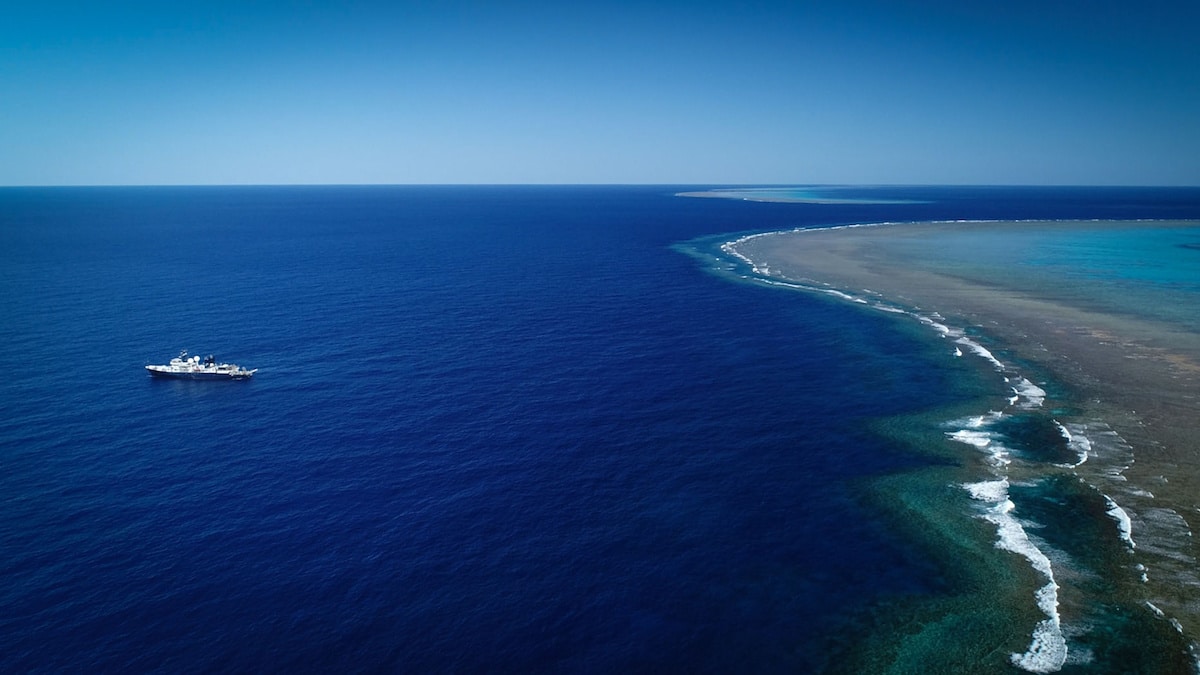
Scientists Discover Massive Coral Reef Taller Than Empire State Building

Schmidt Ocean Institute's R/V Falkor held position as the ROV SuBastian explored the new reef. Dean Miller / Schmidt Ocean Institute
Australian scientists have discovered a massive detached coral reef in the Great Barrier Reef. It is the eighth detached reef discovered in the northern Great Barrier Reef and the first to be discovered in over 120 years.
According to The Guardian, detached reefs are not part of the main body of the Great Barrier Reef and instead spring from the ocean floor off the continental shelf. These types of reefs act like isolated seamounts because there is a lot of deep water between them and the next coral community, explained team lead Robin Beaman to The Guardian. This opens up the possibility of unique species evolving.
The reef was first spotted on Oct. 20 by scientists conducting underwater mapping of the seafloor off of a Schmidt Ocean Institute (SOI) research vessel, reported Newsweek.
“This unexpected discovery affirms that we continue to find unknown structures and new species in our Ocean,” Wendy Schmidt, SOI co-founder, said in a statement.
The team 3-D mapped the reef in detail and used an underwater robot named SuBastian to explore the reef and live-stream video.

A newly-discovered 1,600-foot tall detached reef in the Great Barrier Reef was discovered, 3-D mapped and filmed by Australian scientists. Schmidt Ocean Institute
While the newly discovered reef does not appear to have a lot of hard corals in the shallowest section, SuBastian observed “an incredible abundance” of sponges, sea fans and soft corals in addition to reef fish and grey reef sharks, reported The Guardian. This rich biodiversity suggests that the area is rich in nutrients that are carried from deep waters by strong currents and upwellings, the news report said.
“We are surprised and elated by what we have found,” Beaman said in the SOI statement. “To not only 3D map the reef in detail, but also visually see this discovery with SuBastian is incredible.”
Scientists estimated the reef to be 20 million years old at its deepest point, reported ABC News. The base of the reef is almost 5,000 feet wide, and it rises 1,600 feet tall — dwarfing iconic skyscrapers like the Empire State Building in New York City and the Petronas Twin Towers in Kuala Lumpur, NBC reported. At its shallowest, the peak is just 130 feet below the ocean’s surface.
“To find a new half-a-kilometer tall reef in the offshore Cape York area of the well-recognized Great Barrier Reef shows how mysterious the world is just beyond our coastline,” said Jyotika Virmani, SOI executive director, in the SOI statement. “This powerful combination of mapping data and underwater imagery will be used to understand this new reef and its role within the incredible Great Barrier Reef World Heritage Area.”
According to Newsweek, the Great Barrier Reef is the largest living structure in the world. It comprises nearly 133,000 square miles which include 3,000 coral reefs, 600 continental islands and 150 mangrove islands.
Despite its massive size, the reef is under severe threat. The outlook is “very poor” because the climate crisis has raised ocean temperatures, which can stress corals and cause them to “bleach” or expel symbiotic algae, leaving white coral skeletons exposed. While not deadly, coral bleaching leaves the animal vulnerable, and prolonged or repeated bleaching events have been known to kill coral reefs, reported Newsweek. Recently, another team of scientists estimated that the Great Barrier Reef has already lost half of its corals to the climate crisis.
Co-author of that study, Terry Hughes of James Cook University urged, “We still have an opportunity to save the reef if we deal with climate change. 1.1 degrees of warming so far has triggered five bleaching events since 1998 [but] we still have half a reef,” reported ABC News.
The scientists will continue to map the area until mid-November. Earlier discoveries on this same research cruise included what is believed to be the longest recorded sea creature, a siphonophore potentially longer than 390 feet. The new reef and the other findings will likely lead to years of study, The Guardian reported.
“This is evidence for the importance of exploring our undersea environment so that we can protect it,” SOI spokesperson Carlie Wiener told ABC News.

Scientists used a robot to capture video of the enormous detached reef found off Australia’s northern coast. Schmidt Ocean Institute
- Australia Throws Great Barrier Reef a $300 Million Lifeline, but Will It ...
- The Climate Crisis Has Already Cost the Great Barrier Reef More ...
- Oceans Can Recover by 2050, Study Shows
- This Robot Is Delivering Coral Babies to the Great Barrier Reef ...
- Coral Reefs Could Be Completely Lost to the Climate Crisis by 2100 ...
- First-Ever Aerial Map of Hawaii’s Coral Creates Groundbreaking Conservation Tool - EcoWatch

 233k
233k  41k
41k  Subscribe
Subscribe 